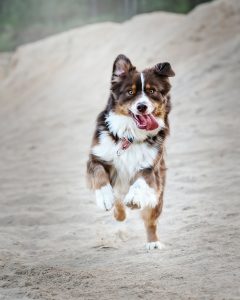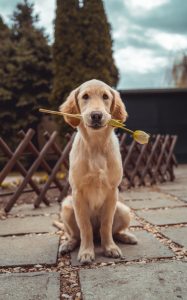Every dog’s face tells a story. And it’s nearing that time of year when you might want to capture that face—to feature it on your holiday cards. Or maybe you want to gift someone some pet photography! Here are five tips to help you score the best photos of your dog.
If you truly want to capture your dog’s essence, consider the location for your shoot. Does your dog love to romp in the stream? Or perhaps it’s a constant game of fetch. Maybe he’s a fan of sticks. Answering these types of questions can help you choose the right spot for your shoot.
If your dog is older, home may be the best bet. You can photograph him while he is going about his daily activities, such as resting on the couch, playing with a favorite toy, or doing other activities he enjoys. This will also help you capture his unique personality.
 Consider Natural Light
Consider Natural Light
Photographing your dog is much the same as with humans. Natural light can give you a better (and easier) outcome than when using flash. (Forget red eyes.)
“The best times for outdoor lighting are in the morning before Noon, which will give a cooler feel to the portrait, and late afternoon to evening which will give a warmer feel,” says professional photographer, Christy Frazier. “Avoid using early afternoon sunlight as it can be harsh and unflattering.”
If you must use a flash: Note that some dogs may find this uncomfortable. Place a piece of wax paper in front of the flash to diffuse the light.
Get the Right Angle 
The most common mistake people make is taking a photograph using a downward angle—it can often distort the image and leave you with an impersonal portrait. Instead, get down on your dog’s level, and view the world from his perspective. The next time your dog is laying on a blanket, for example, take the photo with the camera closer to the ground so you can capture the way his chin rests on his paws.
Get Your Dog’s Attention
Not all dogs are going to sit perfectly and look right at you. You may need to use some treats or noises to get your pup’s ears to perk up. Noises from squeaky toys, whistling or even talking can help make a dog look at you. Just be careful that it isn’t a noise that will make your dog get up and run towards you, unless this is what you want. Treats are helpful if you need your dog to look up at you or off to the side. Dogs react to treats differently, so use what you know works best for your dog to get him to react the way you want.
Sometimes just letting your dog be himself is all you really need. Candid shots will show more of your dog’s personality, and tell the stories you remember.
Come Well Equipped
Digital cameras are highly recommended when taking photographs of your dog. They offer the freedom of multiple back-to-back shots (and even burst mode), and you can check everything instantly.
You may want to consider a tripod or something stable to set your camera on. This will help prevent camera shake as well as keep the angle you intend for your shots.

